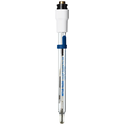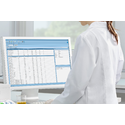What ensures your paint stays vibrant and lasts longer? At Spektrochem, precise pH measurement is the key. See how METTLER TOLEDO’s advanced systems help create stable, durable, and flawless water-based paints that redefine industry standards.
 |
The Secret to Perfect Paint: How pH Shapes Color and Durability. |
The Secret to Perfect Paint: How pH Defines Color and Durability
When choosing the perfect paint color for your walls, the last thing you might consider is pH. Yet, this often-overlooked factor holds the key to achieving vibrant, long-lasting finishes. From ensuring color consistency to preventing microbial degradation, pH plays a critical role in the performance and durability of water-based paints.
In this insightful discussion, Dr. Artur Palasz, Technical Director at Spektrochem—a leading independent laboratory for raw materials in architectural paints—shares his expertise on the science behind pH measurement in paints. Dr. Palasz explains how the precise control of pH affects everything from stability during storage to the quality of the final product applied to surfaces.
Through meticulous research and advanced testing, Spektrochem has refined its approach to pH and conductivity measurements, using advanced equipment from METTLER TOLEDO to tackle the challenges of modern paint formulation. With more than 1,000 samples analyzed annually, Dr. Palasz and his team rely on the reliability and precision of these tools to maintain high standards and meet the evolving needs of their clients in the global paint and coatings industry.
This article delves into the science and practice of pH measurement in water-borne paints, revealing how meticulous attention to this invisible factor can make all the difference in producing paints that are both aesthetically pleasing and structurally sound.
Whether you’re in the paint industry or just curious about the science behind the colors in your life, this is a journey into the technical artistry that ensures your favorite hues stand the test of time.
METTLER TOLEDO (MT): Dr. Palasz, could you tell us about the typical applications of Spektrochem’s formulated paints?
Dr. Palasz: We specialize in water-borne paints for architecture, interior and exterior wall decorations, sports equipment, and gears. These paints are commonly used in building and construction, comprising more than 50% of all water-based paints in the market. You can apply them on surfaces like wood, metal, and building structures and find them in most paint stores.
MT: In the context of paint formulation, what is the relevance of pH, and how frequently is it measured?
Dr. Palasz: In architectural paint, over 50% of the raw materials used in the formulations are pH sensitive during formulation, production, and storage (e.g., polymer binders, fillers, dispersants, biocides, thickeners). pH testing is crucial for ensuring the stability of raw materials used in the formulation of water-borne paints, which could affect the preservative performance. We strive to maintain a consistent pH level for the paint’s stability until the expiry date. It is also important to avoid microbial biological deterioration by maintaining a stable pH level above 7 or 7.5 during formulation. We perform other tests to understand the impact on thickeners and add additives to create stable suspensions and emulsions. Our process includes preparing thickeners through alkalization to achieve the desired viscosity and testing liquid paints for various factors such as viscosity, settling odor, and storage stability.
Our lab collects samples several times daily and measures approximately 800–1,000 samples per year, depending on the number of projects.
MT: Why is it crucial to maintain the pH of water-borne paint formulation above this pH level?
Dr. Palasz: Most paints have a neutral or slightly alkaline pH, but avoiding pH levels below 7 is recommended as it can affect preservative performance. When formulating paint, initial pH levels can be set at 7, 8.5, or 9.5, but the key is to maintain a consistent initial pH level for at least a few months. In water-borne paint formulation, pH monitoring is necessary to identify potential formulation issues.
We primarily measure the pH levels of formulated paints made from various raw materials. In exceptional cases, we also measure the pH of raw materials to verify client data. However, 95% of our work measures the properties of paints derived from raw materials.
About Spektrochem
Established in 2006, Spektrochem Technical Center of Raw Materials for Architectural Paints is an independent lab specializing in technical services and consultancy for the paint and coating industry. The Polish company focuses on the raw materials used in architectural paints, such as fillers, binders, additives, and pigments. It offers various services related to research, development, testing, and optimization of paint and coating formulations. With its state-of-the-art tools and a team of around 12 highly experienced experts, Spektrochem is well-equipped to perform tests like colorimetry, rheology, gloss and haze measurement, adhesion testing, weathering, and more with the utmost precision.
The company’s main market is the US, and now it is planning to open a second lab in the northern region to further expand its footprint.
MT: Can you shed some light on the significance of the conductivity analysis in the paint formulation process?
Dr. Palasz: Conductivity measurement is crucial for testing specific raw materials used in paint formulations, such as dispersing agents and reformers. It is also essential in determining the quality of water used to simulate rain in paint formulation and when it needs to be replaced.
Highly aggressive purified demineralized water is used for weathering and water-emulsion tests to evaluate water quality. A paint sample is immersed in water for seven days, and an initial conductivity measurement is taken. While it’s normal for some paint components to migrate into the water during this time, any increase in conductivity after two or three days can cause unreliable results. An increase in conductivity reduces water aggressiveness, so maintaining the same conductivity level for all tests is crucial.
MT: Do you measure both pH and conductivity using the same meter?
Dr. Palasz: Yes, at our lab, we use the same meter—METTLER TOLEDO’s SevenDirect SD23—with different sensors.
We measure pH levels using the InLab® Pure Pro-ISM, InLab® Science Pro-ISM or InLab® Routine Pro-ISM, and the conductivity analysis is performed using the InLab® 741-ISM sensor. We conduct separate measurements for each parameter to ensure accuracy. The integrated data storage and the automatic export of the data help us to eliminate human error and simplify data handling.
MT: Dr. Palasz, can you explain the appropriate nature and volume of samples for pH and conductivity measurements?
Dr. Palasz: Our samples are liquids with relatively high viscosity but not paste-like consistency. We rely on two of the best sensors available—the METTLER TOLEDO InLab® Pure Pro-ISM and InLab® Science Pro-ISM. These sensors promote an effective flow of electrolytes, which helps prevent impurities and junction clogging. Also, they’re extremely easy to clean and maintain, and with the Intelligent Sensor Management (ISM) system, we’re able to store all data and effortlessly transfer it to the meter, saving us time and ensuring accuracy.
When it comes to measuring the conductivity of water, we rely on the InLab® 741-ISM with the 2-pole cell. This sensor provides exceptional accuracy and precision, making it the ideal choice for our less viscous water samples.
Our standard practice is to measure samples in a 100 ml beaker, with approximately 80 ml of sample. However, we may adjust the sample volume depending on the electrode sensor coverage and immersion required to enable proper electrolyte leakage.
“The METTLER TOLEDO pH system has been instrumental in extending equipment longevity and resolving measurement accuracy issues. Earlier, the electrodes had to be replaced every week due to the nature of the paint samples. However, switching to METTLER TOLEDO electrodes has resulted in significant cost savings as we can use the same electrodes for up to six months.”
 |
Dr. Artur Palasz, Technical Director at Spektrochem, technical center of raw materials for architectural paints. |
MT: Which instruments have you used previously to measure pH and conductivity?
Dr. Palasz: Before moving to the METTLER TOLEDO system, we used a pH meter and sensor from a local producer. Presently, the local setup is only used if there is a suspicion that a sample has an unusual pH level. These local instruments help us to determine whether the samples are safe to use in the current METTLER TOLEDO setup.
MT: What factors led you to switch to the METTLER TOLEDO system?
Dr. Palasz: To maintain our commitment to quality, we only use high-quality global brands, and in many cases, the same equipment our clients use in their labs. As a global leader, METTLER TOLEDO values precision and reliability, and using high-quality equipment not only ensures accurate and consistent results but also helps build trust with our clients.
MT: Can you discuss some common challenges that you encountered during pH measurements and how the METTLER TOLEDO system helped you overcome them?
Dr. Palasz: Paint samples can be incredibly tricky to work with due to the varying degrees of hardness of the crystal fillers, such as quartz and aluminum oxide. These fillers have sharp, angular shapes that can cause scratches to the surface of the electrode, which could interfere with the contact of the sample and cause inaccurate readings, also hampering the electrode’s lifespan. Another challenge is that the paint samples are very difficult to mix even with magnetic stirrers, causing increased abrasion on the electrode surface.
METTLER TOLEDO electrodes have been a game-changer, which allowed us to overcome these challenges. Their high membrane stability is especially effective when working with hard crystal-containing paint samples. We now use these electrodes for up to 6 months, a significant cost-saving improvement compared to the weekly replacements previously. We also use METTLER TOLEDO single-use sachet buffers to eliminate contamination risk or dilution. Additionally, the EasyDirect software streamlines communication between the PC and the software, saving time and
improving lab efficiency.
As an accredited lab for pH measurements, we value precision and reliability, which is why we rely on METTLER TOLEDO products.
 |
 |
MT: Dr. Palasz, what unique features set METTLER TOLEDO products apart from other options in the market? Based on your experience, do you believe that our products are worthwhile investments for other companies to consider?
Dr. Palasz: We use the SevenDirect meter and various sensors. What we like about METTLER TOLEDO products is that they are easy to navigate, offer seamless data transfer, and effortlessly allow switching between pH or conductivity parameters. They offer a choice of languages which helps to accommodate our international team. The sensors are easy to calibrate, produce precise readings, and yield reliable and reproducible results.
We not only use and recommend these products but also create awareness of their quality and precision. As an independent laboratory, we collaborate with numerous companies in the United States and many of our clients have switched to METTLER TOLEDO products after seeing their effectiveness in our lab.
MT: Dr. Palasz, thank you for your time and for sharing valuable insights about paints. It was a pleasure speaking with you!
Dr. Palasz: Thank you. I enjoyed our conversation as well. Happy to chat anytime about paints or related topics!
 |
 |
Dr. Kajal Jaiswal |
Kajal Jaiswal is a Scientific Marketing Specialist at METTLER TOLEDO, expertly bridging the divide between scientific research and marketing strategy.
With a Ph.D. in chemistry and extensive experience in scientific writing, she possesses a robust understanding of both theoretical and practical aspects of the field. In her current role, Kajal provides SEM-focused support to the SBU pH Lab, ensuring that marketing initiatives are seamlessly aligned with scientific advancements and customers' needs.
 |
Parul Chhaparia |
Parul Chhaparia is a Content and Marketing Communications Specialist at METTLER TOLEDO, where she crafts impactful campaigns that bridge scientific expertise with engaging storytelling.
With a background in business journalism and extensive experience in creating content that simplifies complex scientific topics, Parul combines analytical precision with creative flair. Beyond her work at METTLER TOLEDO, she enjoys traveling to uncover stories about people, cultures, and places, fueling her passion for discovery and connection.









